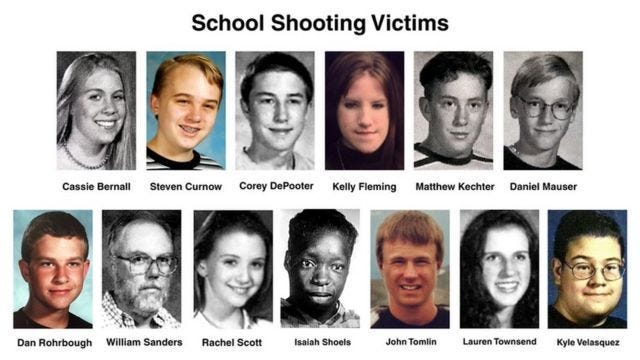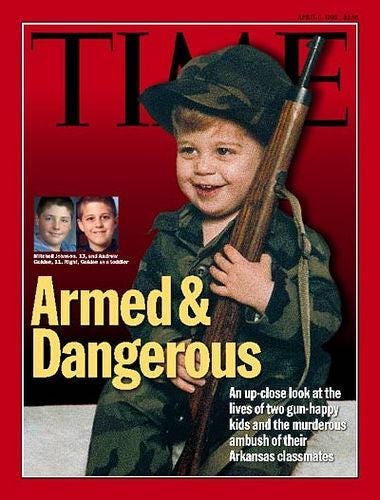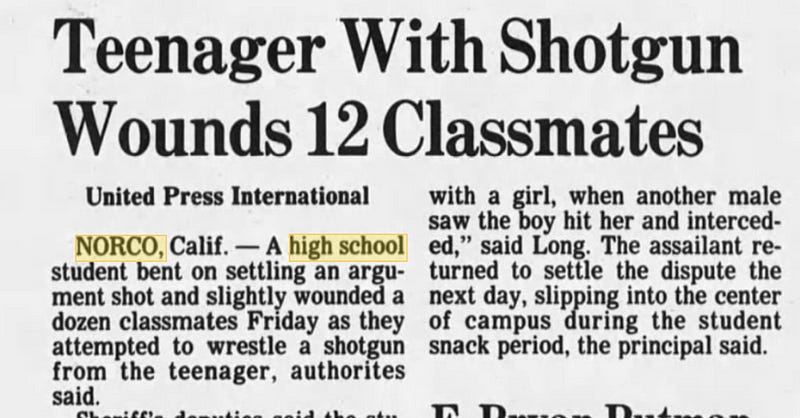20 Years Later: 349 Deaths from Guns in Schools Since Columbine
Columbine. The context of “high school” or “shooting” is no longer needed for almost any American of a certain age to vividly recall this…
Update (4/20/2022): Since this article was published on 4/20/2019, at least 107 students, teachers, parents, and other community members have been killed by gunfire on school property. 328 others have been wounded.
Columbine. The context of “high school” or “shooting” is no longer needed for almost any American of a certain age to vividly recall this incident. ‘Columbine’ has become the singular descriptor of a tragedy of such abrupt shock and horror that it’s become part of the American lexicon, particularly when discussing school shootings. Columbine was a watershed moment in shaping the country’s view on school shootings, but it was not the first nor the last school shooting. Even 20 years later, it’s remembered more vividly than many recent attacks although it’s just one example of more than 1,360 different incidents that have happened in schools across the country over the last 50 years. Many might be surprised to learn that in fact, 29 of the 50 most deadly school shootings from 1970–2019 occurred before Columbine.
Since the Columbine shooting on April 20, 1999, there have been 727 different incidents in which a gun was fired on school property. This 727 total has resulted in 349 deaths and 674 injuries. While many of these incidents were isolated disputes, accidents, suicides, and domestic violence, there have been 49 different planned attacks on schools. These planned attacks have resulted in 102 deaths and 124 injuries.
Why does Columbine stand out when other incidents bore such striking similarities? What put Columbine on the map that didn’t happen in the years prior?
In 1998, just one year before Columbine, two students carried out a planned shooting attack on their school at Westside High School in Jonesboro, Arkansas. Johnson (13, male) stole his parent’s car and went with Golden (11, male) to his grandparent’s house where they both knew guns were unlocked. The two assailants drove to the school, pulled the fire alarm, and hid in bushes while they fired at the exiting students. The shooters had 9 weapons and 2000 rounds of ammo. They fled the scene in the parent’s van but were apprehended by police. Both were known as bullies. Both talked about wanting to be members of the “bloods” street gang but had a “lot of killing to do first”. Golden was known to have frequent fights and had already shot a female student’s cat. Johnson was sexually abused at age 6 and abused a 3 year old girl when he was 12. Both were released when they turned 21 due to state laws.
In 1997 at Pearl High School in Alabama, a student killed his mother, stole her car, and drove to school with a rifle. He wore a trench coat to conceal the rifle while walking into school then proceeded to shoot at his ex-girlfriend, her friend, and then moved on to other random students. The shooter fled in the car but got stuck in the field behind the school where he was held at gunpoint by the assistant principal, who happened to be armed, until police arrived. The shooter had talked about his plan to attack the school with multiple other students and 5 other students were charged with conspiracy. The shooter was a good student and excelled in art but had been extensively bullied.
Even further back in 1990, at Charlestown High School in Indiana, a good student who was well liked had been suspended twice for breaking a window and pulling a fire alarm during pranks. He came to school with a gun and held 15 students and a teacher hostage for 8 hours in a classroom. During the standoff, other students were in disbelief that it was him and told police he would not hurt anyone. The shooter’s father was a police officer. He eventually surrendered without firing a shot.
In 1984 at Norco High School in California, a 17 year old male student had been involved in a dispute with a female and male student the prior day. The next day, he brought a shotgun to the school and fired in the hallway, injuring 12 students. After the first shots, other students tackled the shooter. Luckily the shotgun was loaded with light birdshot. Different ammunition could have resulted in more severe injuries and deaths.
It’s ironic that Columbine became the most infamous school shooting incident because it was never intended to be a shooting. The two attackers intended to copycat the Oklahoma City Bombing with a more spectacular and deadly explosion that would level the entire school building. Unlike McVeigh who was trained in the operation of explosives from his military service and had the resources to assemble a giant truck bomb, the Columbine attackers placed a crude assortment of improvised explosives around the school. When their bombs didn’t go off, plan B was to wander around the school firing at random students until they killed themselves.
What remains unclear about Columbine is exactly what motivated the shooters. The prevailing belief about most school shootings is the perpetrators are mentally ill, dark and disturbed social outcasts who decide indiscriminate violence is their perverse way to gain notoriety. The circumstances surround school shootings are actually far more complicated than that.
New Research on School Shootings
The K-12 School Shooting Database provides a holistic picture of all types of firearms related incidents at US schools from 1970–present. This data allows for a broader analysis of the issue showing that school shootings are a very complex problem that span all geographic areas regardless of population density, socioeconomics, and diversity.
Not all school shooters are deranged maniacs. Shooting incidents occur for many different reasons and as a result, the database is organized into 15 different categories based on the circumstances of the incident:
Gang-related
Domestic w/ Targeted Victim
Murder-Suicide
Suicide or Attempted Suicide
Escalation of Dispute
Bullying
Robbery
Accidental
Indiscriminate Shooting
Mental Health
Anger Over Grade, Suspension, or Discipline
Racial
Self Defense
Illegal Drug Related
Hostage Standoff
These categories are a demonstration of how difficult school shootings are to predict and prevent because they are committed by all kinds of people (not just students) for many different reasons.
Columbine 20 Years Later
Anniversaries are an opportunity to reflect and remember. This article should not be construed as downplaying the tragic loss of life at Columbine or the severity of the incident. The complex problem of school shootings is bigger than just the circumstances surrounding Columbine. School shootings are a systemic issue that has existed across our society for 50 years and sadly will continue into the future. If we ever hope to solve this problem, a broad analysis and understanding of every circumstance leading up to a school shooting is necessary to develop any meaningful solutions.
David Riedman is the creator of the K-12 School Shooting Database and a national expert on school shootings. Listen to my recent interviews on Freakonomics Radio, New England Journal of Medicine, and Iowa Public Radio the day after the Perry High shooting.







